Topexaminer001
i am a health and medical practioner who is specialised in helping students to equip skills in nursing,mathematics and more about economics.
My documents will able to meet your needs adequately.
- 348
- 0
- 0
Community
- Followers
- Following
348 items
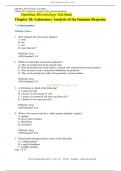
OpenStax Microbiology Test Bank Chapter 20: Laboratory Analysis of the Immune Response
OpenStax Microbiology Test Bank Chapter 20: Laboratory Analysis of the Immune Response * = Correct answer Multiple Choice 1. Most antigens have how many epitopes? A. none B. one C. two D. more than two* Difficulty: Easy ASM Standard: N/A 2. Which best describes monoclonal antibodies? A. They are produced in living animals only. B. They are produced in tissue cultures, using B cells extracted from living animals.* C. They are rarely used, so polyclonal antibodies are preferred. D. ...
- Exam (elaborations)
- • 18 pages •
OpenStax Microbiology Test Bank Chapter 20: Laboratory Analysis of the Immune Response * = Correct answer Multiple Choice 1. Most antigens have how many epitopes? A. none B. one C. two D. more than two* Difficulty: Easy ASM Standard: N/A 2. Which best describes monoclonal antibodies? A. They are produced in living animals only. B. They are produced in tissue cultures, using B cells extracted from living animals.* C. They are rarely used, so polyclonal antibodies are preferred. D. ...

OpenStax Microbiology Test Bank Chapter 19: Diseases of the Immune System
OpenStax Microbiology Test Bank Chapter 19: Diseases of the Immune System * = Correct answer Multiple Choice 1. An allergy is an example of which of the following? A. a type I hypersensitivity* B. a type II hypersensitivity C. a type III hypersensitivity D. a type IV hypersensitivity Difficulty: Easy ASM Standard: N/A 2. If someone were accidentally given blood of the wrong type, which of the following is likely to occur? A. an autoimmune disorder B. anaphylaxis C. a hemolytic ...
- Exam (elaborations)
- • 20 pages •
OpenStax Microbiology Test Bank Chapter 19: Diseases of the Immune System * = Correct answer Multiple Choice 1. An allergy is an example of which of the following? A. a type I hypersensitivity* B. a type II hypersensitivity C. a type III hypersensitivity D. a type IV hypersensitivity Difficulty: Easy ASM Standard: N/A 2. If someone were accidentally given blood of the wrong type, which of the following is likely to occur? A. an autoimmune disorder B. anaphylaxis C. a hemolytic ...
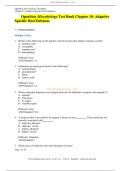
OpenStax Microbiology Test Bank Chapter 18: Adaptive Specific Host Defenses
OpenStax Microbiology Test Bank Chapter 18: Adaptive Specific Host Defenses * = Correct answer Multiple Choice 1. Which of the following are the primary cells involved in the adaptive immune system? A. dendritic cells B. eosinophils C. lymphocytes* D. macrophages Difficulty: Easy ASM Standard: 14 2. Antibodies are made up of which of the following? A. carbohydrates B. glycoproteins* C. lipids D. nucleic acids Difficulty: Easy ASM Standard: 14TESTBANKSELLER.COM 3. Which molecu...
- Exam (elaborations)
- • 17 pages •
OpenStax Microbiology Test Bank Chapter 18: Adaptive Specific Host Defenses * = Correct answer Multiple Choice 1. Which of the following are the primary cells involved in the adaptive immune system? A. dendritic cells B. eosinophils C. lymphocytes* D. macrophages Difficulty: Easy ASM Standard: 14 2. Antibodies are made up of which of the following? A. carbohydrates B. glycoproteins* C. lipids D. nucleic acids Difficulty: Easy ASM Standard: 14TESTBANKSELLER.COM 3. Which molecu...
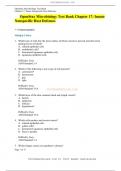
OpenStax Microbiology Test Bank Chapter 17: Innate Nonspecific Host Defenses
OpenStax Microbiology Test Bank Chapter 17: Innate Nonspecific Host Defenses * = Correct answer Multiple Choice 1. Which type of cells line the inner surface of blood vessels to prevent microbes from gaining access to blood? A. ciliated epithelial cells B. endothelial cells* C. keratinized squamous epithelial cells D. squamous epithelial cells Difficulty: Easy ASM Standard: 14 2. Which of the following is not a type of cell junction? A. centromere* B. desmosome C. gap D. tight ...
- Exam (elaborations)
- • 19 pages •
OpenStax Microbiology Test Bank Chapter 17: Innate Nonspecific Host Defenses * = Correct answer Multiple Choice 1. Which type of cells line the inner surface of blood vessels to prevent microbes from gaining access to blood? A. ciliated epithelial cells B. endothelial cells* C. keratinized squamous epithelial cells D. squamous epithelial cells Difficulty: Easy ASM Standard: 14 2. Which of the following is not a type of cell junction? A. centromere* B. desmosome C. gap D. tight ...
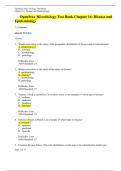
OpenStax Microbiology Test Bank Chapter 16: Disease and Epidemiology
OpenStax Microbiology Test Bank Chapter 16: Disease and Epidemiology * = Correct answer Multiple Choice 1. Which term refers to the study of the geographic distribution of disease and its transmission? A. epidemiology* B. etiology C. morbidology D. pathology Difficulty: Easy ASM Standard: 23 2. Which term refers to the study of the cause of disease? A. epidemiology B. etiology* C. morbidology D. pathology Difficulty: Easy ASM Standard: 23 3. Tetanus, which is caused by Clostrid...
- Exam (elaborations)
- • 18 pages •
OpenStax Microbiology Test Bank Chapter 16: Disease and Epidemiology * = Correct answer Multiple Choice 1. Which term refers to the study of the geographic distribution of disease and its transmission? A. epidemiology* B. etiology C. morbidology D. pathology Difficulty: Easy ASM Standard: 23 2. Which term refers to the study of the cause of disease? A. epidemiology B. etiology* C. morbidology D. pathology Difficulty: Easy ASM Standard: 23 3. Tetanus, which is caused by Clostrid...
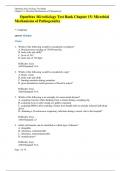
OpenStax Microbiology Test Bank Chapter 15: Microbial Mechanisms of Pathogenicity
OpenStax Microbiology Test Bank Chapter 15: Microbial Mechanisms of Pathogenicity * = Correct answer Multiple Choice 1. Which of the following would be considered a symptom? A. blood pressure reading of 150/90 mm Hg B. body ache and chills* C. fever of 39 C D. heart rate of 120 bpm Difficulty: Easy ASM Standard: N/A 2. Which of the following would be considered a sign? A. blurry vision B. body ache and chills C. burning sensation during urination D. gross hematuria (visible p...
- Exam (elaborations)
- • 20 pages •
OpenStax Microbiology Test Bank Chapter 15: Microbial Mechanisms of Pathogenicity * = Correct answer Multiple Choice 1. Which of the following would be considered a symptom? A. blood pressure reading of 150/90 mm Hg B. body ache and chills* C. fever of 39 C D. heart rate of 120 bpm Difficulty: Easy ASM Standard: N/A 2. Which of the following would be considered a sign? A. blurry vision B. body ache and chills C. burning sensation during urination D. gross hematuria (visible p...
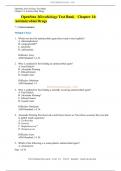
OpenStax Microbiology Test Bank Chapter 14: Antimicrobial Drugs
OpenStax Microbiology Test Bank Chapter 14: Antimicrobial Drugs Page 1 of 20 TESTBANKSELLER.COM #1 TEST BANKS WHOLESALER OpenStax Microbiology Test Bank Chapter 14: Antimicrobial Drugs * = Correct answer Multiple Choice 1. Which was the first antimicrobial agent discovered to treat syphilis? A. chloramphenicol B. compound 606* C. penicillin D. sulfonamide Difficulty: Easy ASM Standard: 14, 23 2. Who is credited for first finding an antimicrobial agent? A. Paul Ehrlich* B. Al...
- Exam (elaborations)
- • 21 pages •
OpenStax Microbiology Test Bank Chapter 14: Antimicrobial Drugs Page 1 of 20 TESTBANKSELLER.COM #1 TEST BANKS WHOLESALER OpenStax Microbiology Test Bank Chapter 14: Antimicrobial Drugs * = Correct answer Multiple Choice 1. Which was the first antimicrobial agent discovered to treat syphilis? A. chloramphenicol B. compound 606* C. penicillin D. sulfonamide Difficulty: Easy ASM Standard: 14, 23 2. Who is credited for first finding an antimicrobial agent? A. Paul Ehrlich* B. Al...
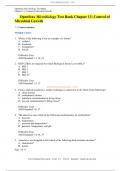
OpenStax Microbiology Test Bank Chapter 13: Control of Microbial Growth
OpenStax Microbiology Test Bank Chapter 13: Control of Microbial Growth * = Correct answer Multiple Choice 1. Which of the following is not an example of a fomite? A. catheter B. doorknob C. mosquitoes* D. towels Difficulty: Easy ASM Standard: 13, 14, 23 2. HEPA filters are required for which Biological Safety Level (BSL)? A. BSL 1 B. BSL 2 C. BSL 3 D. BSL 4* Difficulty: Easy ASM Standard: 14, 37TESTBANKSELLER.COM 3. From a clinical perspective, aseptic technique is carried out...
- Exam (elaborations)
- • 19 pages •
OpenStax Microbiology Test Bank Chapter 13: Control of Microbial Growth * = Correct answer Multiple Choice 1. Which of the following is not an example of a fomite? A. catheter B. doorknob C. mosquitoes* D. towels Difficulty: Easy ASM Standard: 13, 14, 23 2. HEPA filters are required for which Biological Safety Level (BSL)? A. BSL 1 B. BSL 2 C. BSL 3 D. BSL 4* Difficulty: Easy ASM Standard: 14, 37TESTBANKSELLER.COM 3. From a clinical perspective, aseptic technique is carried out...
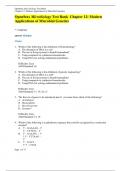
OpenStax Microbiology Test Bank Chapter 12: Modern Applications of Microbial Genetics
OpenStax Microbiology Test Bank Chapter 12: Modern Applications of Microbial Genetics * = Correct answer Multiple Choice 1. Which of the following is the definition of biotechnology? A. The alteration of DNA in a cell B. The use of living systems to benefit humankind* C. Using computers to synthesize biomolecules D. Using DNA for solving mathematical problems Difficulty: Easy ASM Standard: 26 2. Which of the following is the definition of genetic engineering? A. The alteration of D...
- Exam (elaborations)
- • 18 pages •
OpenStax Microbiology Test Bank Chapter 12: Modern Applications of Microbial Genetics * = Correct answer Multiple Choice 1. Which of the following is the definition of biotechnology? A. The alteration of DNA in a cell B. The use of living systems to benefit humankind* C. Using computers to synthesize biomolecules D. Using DNA for solving mathematical problems Difficulty: Easy ASM Standard: 26 2. Which of the following is the definition of genetic engineering? A. The alteration of D...
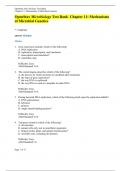
OpenStax Microbiology Test Bank Chapter 11: Mechanisms of Microbial Genetics
OpenStax Microbiology Test Bank Chapter 11: Mechanisms of Microbial Genetics * = Correct answer Multiple Choice 1. Gene expression includes which of the following? A. DNA replication B. replication, transcription, and translation C. transcription and translation* D. translation only Difficulty: Easy ASM Standard: N/A 2. The central dogma describes which of the following? A. the process by which enzymes are modified after translation B. the steps of gene expression* C. the way DNA...
- Exam (elaborations)
- • 18 pages •
OpenStax Microbiology Test Bank Chapter 11: Mechanisms of Microbial Genetics * = Correct answer Multiple Choice 1. Gene expression includes which of the following? A. DNA replication B. replication, transcription, and translation C. transcription and translation* D. translation only Difficulty: Easy ASM Standard: N/A 2. The central dogma describes which of the following? A. the process by which enzymes are modified after translation B. the steps of gene expression* C. the way DNA...
